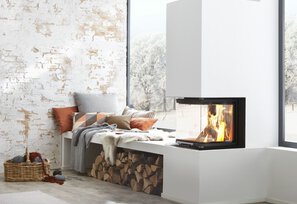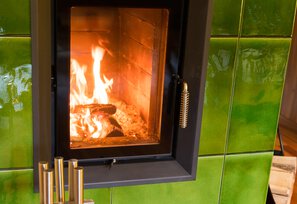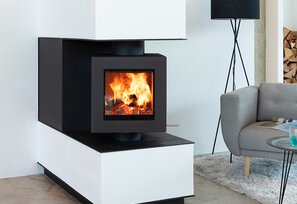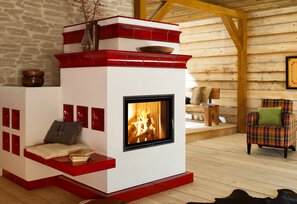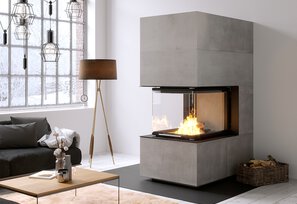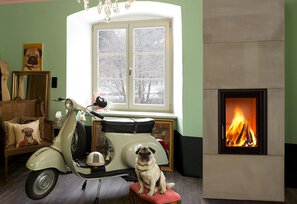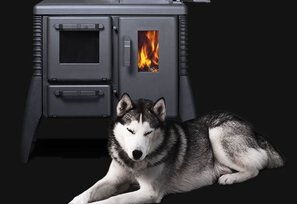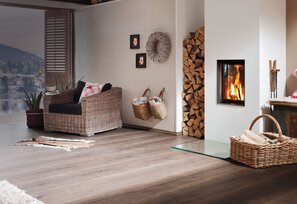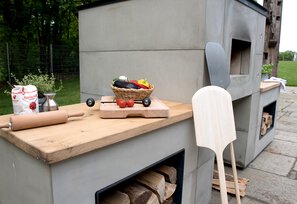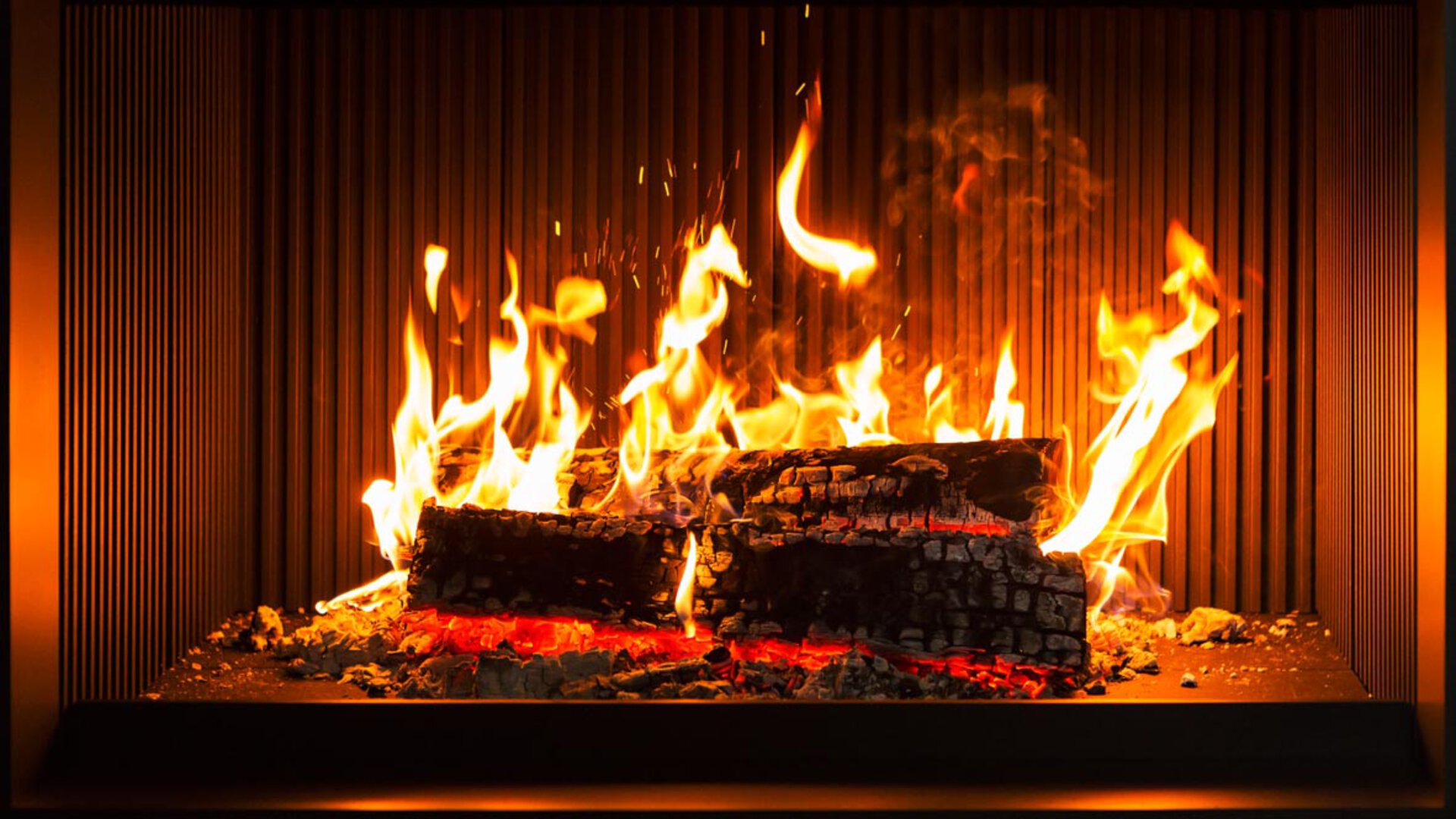Masonry heater
More heating power is not possible
Particularly long-lasting heat storage
A masonry heater is also called a storage heater or radiant heater because it heats the installation room with pleasant radiant heat. The masonry stove is considered to be the most original tiled stove and is usually built by hand by the furnace builder. However, there are also prefabricated BRUNNER components such as a combustion chamber made of fireclay or storage placed on top or next to it.
Primarily heat
Storage for the masonry heater
A BRUNNRER masonry heater only needs to be heated around twice a day, more often is not necessary because the combustion chamber can be filled with around 18 kilograms of wood. The efficiency is over 80 percent.
To ensure that the living area of the house is not overheated when the stove burns down, storage heaters are designed in such a way that the heat is stored in storage across which heating gas flows and is then released again with a time delay of many hours in the form of radiant heat. How much storage is necessary depends on the size and design of the firebox and the amount of fuel. This is lower with storage mounted on top.
Specifications for individual combustion systems
What does masonry heater mean?
In Germany, the "Ordinance on Small and Medium-Sized Furnaces" defines what a masonry heater is. There, the masonry heater is a "single-room fireplace as a heat storage furnace made of mineral storage materials that are set on site by hand." A fireplace that has no fire grate and is only fired with logs is also often called a masonry heater. Usually three to 18 kilograms of wood are used for one filling. Masonry heaters have a ceramic storage across which heating gas flows. The ash collects directly on the floor after burn-off The more optimum the design of the stove, the smaller the amount of ash. A masonry heater with a large firebox often only needs to be emptied after 50 or more burn-offs. When it comes to the design and material of a masonry heater, there are no limits to the customer's and furnace builder's imagination; he can also design it in such a way that it hardly differs in appearance from a fireplace.
A masonry heater is a single-room combustion system according to the law if it primarily heats the room in which it is placed. According to the new version of the Federal Immission Act, a type test is mandatory for all new single-room furnaces. This involves checking whether the fireplace or tiled stove complies with the emission limits (Stage 2) and the minimum efficiency levels. For this purpose, sellers must issue a corresponding type certificate, which can be presented to the chimney sweep, for example. For already existing individual furnaces, if they do not comply with the limit values of stage 1, they must be retrofitted or decommissioned.
Masonry heater kit
The Lower Bavarian premium manufacturer BRUNNER has developed special components for the masonry heater:
- The construction of the door to the firebox is particularly durable and has a high level of resistance.
- The firebox made of fireclay is type-tested. Low-emission operation is guaranteed, as prescribed in Germany by the 1st Federal Immission Control Ordinance (Stage 2), in Austria by Article 15a of the Federal Immission Control Act (BVG), and by construction methods in accordance with eco-label ZU 37.
- Storage is made of modular storage bricks for the passage of heating gases, which can be placed on top or next to each other.
The furnace builder optimally matches these basic stove components to each other in terms of their heat output after which they are installed. The result is a storage furnace that makes heating with wood a real pleasure. BRUNNER offers compact masonry heaters with small glazing and large masonry heaters with glazing in fireplace format.

The stove doors
View on the fire
As far as appearance is concerned, a heat storage furnace does not have to differ from a modern fireplace, thanks to the different door formats by BRUNNER. They can be used to create radiant heaters with different fireplace glass formats, depending on your individual liking. While the fire is still burning in the stove, the firebox radiation delivers rapid heat into the room through the viewing glass. However, the size and geometry of the glass should always also be based on the heat requirements of the installation room. Large doors in standard design are therefore recommended for storage heaters with a fireplace look in the living area. Corner doors with high heat output are well suited for large installation rooms and cast-iron doors for traditional designs or when heating from the adjoining room.
After combustion, the storage then provides the pleasant radiant heat described. What makes BRUNNER masonry heater doors so special?
The design of the firebox doors with integrated air flow allows wood quantities of up to 18 kilograms to be used.
Type-tested masonry heater combustion chambers are available to match.
Two connection points with a diameter of 160 millimetres (6.29 inches ) supply the fireplace with combustion air from outside.
They have secondary air/secondary air connections for combustion chamber depths of less than 60 centimetres (23.62 inches.) and comply with the legal requirements (also in Austria).

Safety for the masonry heater
For a masonry heater to function safely, there must always be sufficient negative pressure available in the chimney. To ensure this at all times, there is the BRUNNER negative pressure control (USA). From the point of heating up, it monitors whether sufficient negative pressure is built up by the chimney. Only then can the heating gases be safely discharged. If this chimney impact is prevented, for example, by a kitchen extractor hood or a defective ventilation system, the USA automatically switches off the fault factors.
A masonry heater for long-lasting warmth
Type-appropriate combustion chamber in large and small
Environmental compatibility, emission values and the efficiency of an individually installed masonry heater always depend on the furnace builder's skills. To make these parameters less dependent on the latter's expertise, BRUNNER manufactures its masonry heaters from dry-pressed, high-quality fireclay bricks or modules. For type-compliant combustion chambers that meet the legal requirements.
The tested fireboxes are available in various sizes and designs and with large or small glazing. For small masonry heaters, the single-shell "KastenFeuerRaum"(Firebox), or KFR for short, with a small viewing glass and a compact design is used. If no individual shapes are desired, the furnace builder uses storage matched to the respective KFR. The combustion chamber of the masonry heater, jointly with the storage, stands on a robust support frame and a draught system for the passage of the heating gases is mounted next to or behind the combustion chamber. The surface design of the stove casing can be done with tiles, depending on taste. Because large masonry heater combustion chambers with a large glass
are exposed to greater thermal and mechanical loads, these stove bodies are always constructed with two shells. This means that the inner combustion chamber, which is directly exposed to the fire, can expand and move thermally and is held tightly together by a second cover. Masonry heater Tunnels are furnace where the fire can be seen from two sides. The stove is then created as a room divider depending on structural specifications or can be fuelled from two rooms.

The difference
Tiled stove and masonry heater
At first glance, masonry tiled stoves and masonry heaters resp. storage heaters can hardly be distinguished from each other from the outside. The different technology is hidden inside the system.


The tiled stove
A tiled stove is usually made of stove tiles by a master stove fitter. There are also installations made of bricks that are plastered. The lining of a tiled stove with fireclay bricks in the combustion chamber and the fitting of flues did not appear until the 20th century. A tiled stove can absorb large amounts of heat and release it into the room over a long period of time - also because of the fireclay bricks, which store the heat that is generated. The appearance of masonry tiled stoves has changed a lot in recent years. Nowadays, they are very rarely tiled, and the typical green stove tile is hardly ever seen anymore. Simple and puristic designs with clear lines, a lot of white plastered surface in combination with rich brown tones or black and large viewing windows dominate. Large-format ceramics are often used for fire tables and benches.
A tiled stove works like a hot-air stove. Behind its casing there is a heating insert - BRUNNER is regarded as the leading manufacturer of heating inserts - and at the flue of the heating insert there is a reheating unit, so that not only the heat from the combustion chamber can be used, but also the heat from the flue gases. The installation room is heated by hot air from the stove. At the same time, part of this heat is stored in a reheating box and only released over time. This means that a tiled stove cannot heat the room as quickly as a wood stove, but it can do so for much longer, even hours after the fire has gone out.
The masonry heater
The oldest representative of all tiled stoves is the masonry heater. All components can be handcrafted by the master stove maker or it can be designed with a prefabricated firebrick combustion chamber and storage modules. There are no limits to the imagination when it comes to design and materials. A masonry heater can be heated with three to 18 kilograms of wood. It is equipped with a ceramic mass storage across which heating gas flows. A masonry heater stores the released energy in this mass. The heating effect is achieved by heat radiation through the stove cover. This so-called radiant heat is perceived as particularly pleasant. The storage determines the amount and duration of the heating power. If a lot of storage mass is installed, the surface temperature is low. This makes it almost impossible to overheat a room. A masonry heater takes a long time to heat up, but it stays warm for a long time. It is recommended to heat it at least once a day during the entire heating season
.Easy to operate
Simple and uncomplicated
Manually operated or automated
The combustion air can be controlled manually with just one operating element (lever). Effortless and easy to understand. The symbols on the glass provide additional support.
Of course, the white display (EAS) shows that it can also be operated automatically. The most convenient version is the combination with an electronic combustion control (EAS). All you have to do is light the stove or add fuel, the control system takes care of everything else. High efficiency is the result, because the EAS servomotor never forgets to readjust and always stops the combustion air supply at the end of the burn-off. This is particularly convenient if the stove cannot be operated any further after its kindling, either because you go to bed or you leave the house.

How much does a masonry heater cost?
A modern masonry heater is far more than just a further development of grandma's tiled stove. But then as now, the stove is the heart of every home, also because warmth is a basic human need. An investment in a basic stove is therefore always a worthwhile investment, because the focus here is not on the fire, but on the heating power.
The prices for masonry heaters, depending on the version, start at 5,000 euros - this does not include the work of the furnace builder. The more exclusive the design or the materials, the more expensive the stove will be. You should also clarify in advance whether the existing chimney is sufficient for the operation of the stove. If not, it will have to be retrofitted, which will also drive up the costs.
Robust masonry heater
Advantages and disadvantages of a masonry fireplace
The following speaks in favour of a masonry fireplace: It has a high thermal effect and a high heat storage capacity, so a flat stays warm for a long time, even overnight. The heat output can be optimised via the built-in storage without overheating the room. However, it takes time to set up a masonry fireplace system, usually - depending on the system - between two days and two weeks. Typical tiled stoves are usually erected in one week. In addition, a masonry fireplace is more expensive and cannot be removed compared to a stove. So it is only worthwhile in a home of one's own.
The advantage of a wood stove is its price, it is much cheaper than a tiled stove or masonry heater and installation and dismantling is done quickly. Its heat output is fast, but it does not store anything. When the fire is out, the heating circuit also goes out and the wood stove becomes cold again.

Similar to a tiled stove, a masonry heater is also a so-called storage heater. Heat energy is stored via a downstream mass and released into the living space over a longer period of time. The difference from a tiled stove is that a masonry heater is made of mineral storage materials (e.g. fireclay stone). This makes masonry heaters even better suited for long-lasting heat transfer than tiled stoves. Especially in the Alpine region, there is a great tradition for this very original type of wood heating. Masonry heaters are often still entirely handmade
.Right now, the need for slow-reacting wood fire inserts such as masonry or tiled stoves is increasing again. Newly built houses are becoming denser and have a significantly lower heat demand than older buildings. To avoid overheating, an energy source is needed that gives off moderate but steady heat to the well-insulated living space. And this is exactly where a masonry stove comes into its own. Thanks to our large selection of viewing glass and size formats, there is no need to do without a fire atmosphere. Even systems with projecting glass sizes are possible as they offer the perfect mix of long-lasting warmth and visual brilliance.
To ensure that everyone can really enjoy a masonry heater in their living room, they are available with both small and large fireboxes. This is made possible by different designs - from rather prefabricated solutions to large masonry heating systems for rooms with an area of over 50 square metres. Our small, compact masonry heaters with a small viewing glass are suitable for storage of up to 500 kg and a filling quantity of 3 to 8 kg. The larger representatives with mostly larger glass formats can serve up to 1,200 kg of storage and can be equipped with a filling quantity of up to 18 kg.
A basic stove, the firebox of which is also built by hand, can only heat as environment-friendly as its user is skilled. That is why we at BRUNNER offer type-tested, prefabricated masonry heater fireboxes and doors. We thus guarantee a clean solution in terms of emissions and efficiency, without having to forego the "masonry heater" experience. Due to the maximum energy yield with the help of the mineral firebox and the massive reheating surface, the masonry heater is probably the most efficient way of heating with wood.
And for many of our customers also the most beautiful choice.
One aspect that is often forgotten alongside years of experience and unique quality are the details that round off the stove or fireplace experience. BRUNNER was the first manufacturer to produce innovations in the field of electronic stove control back in 1991 and revolutionised the stove industry. Sophisticated safety systems such as the low pressure control (USA) give a good feeling every time you heat up the stove. And practical innovations such as prefabricated storage stones (MSS), kit system covers for masonry heaters or the so-called Heatstop demonstrate that BRUNNER simply thinks ahead. Everything from a single source - everything for a perfect fire experience.
Consult your furnace builder to find the right heating insert for your home.
Also use our social media channels to get inspired.

